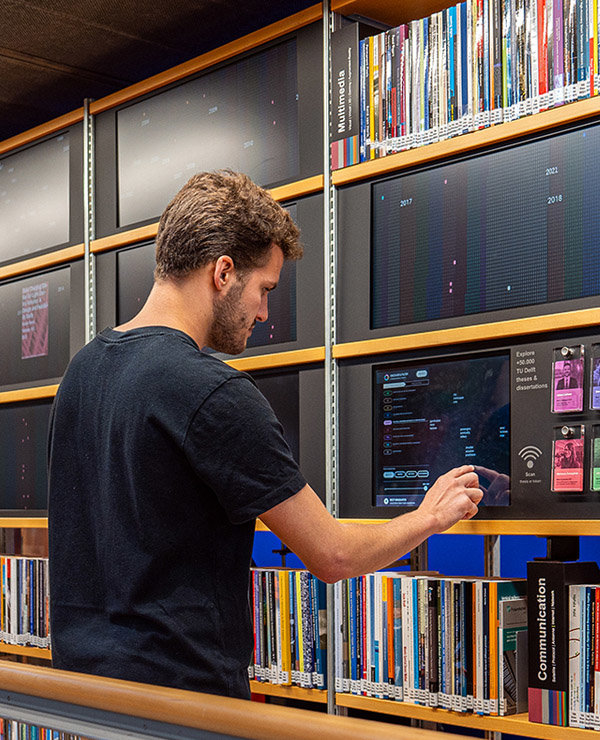


Collection Wall project
Exploring the opportunity space
TU Delft Library is undergoing a transformation, turning its iconic book wall into the Collection Wall—an interactive experience designed to inspire exploration, discovery, and serendipity. This innovative project will visualize and activate both our physical and digital collections, fostering new connections and narratives for educational purposes and cultural programming. It stands as a key component of our mission to engage visitors through our library collections.
We invite you to join us on this exciting journey of collaborative digital transformation. Help us to improve the prototype in collaboration with the visitors: Come to the library and interact with the Collection wall. How? Check out this short clip! Please share your feedback with the Library and project developers by filling in a short online survey.
Visit and discover lost knowledge through the Collection Wall Prototype #2. This latest iteration showcases a renewal of the Wall through a collaboration with inspired students. Engage, experience, and become part of the Collection Wall!
“These objects are the foundation of innovations that we make today”.
Experience goals
- Bring visibility to library collections beyond physical books
Users become more aware of TU Delft’s rich and vast collections - Inspire exploration, enquiry and serendipity
Users make new connections within the realm of their studies and research - Enable collaboration, interaction and contribution
Users activate collections, create narratives and become part of the discourse
Check out the Collection Wall process and how we have been collaboratively transforming static resources into dynamic sources of inspiration.
Questions?
Contact
Alice Bodanzky, Project Manager
Email: A.MottaMaiaBodanzky@tudelft.nl
Phone: +31 (0)6 83627351
Prototypes
CW prototype #3
The Collection Wall prototype #3 explores new ways of enhancing visitor interaction with the physical books at the wall. The AI Librarian Holo-vitrine experience combines artificial intelligence and RFID technology to offer students career predictions based on the books they scan. Positioned between the shelves, it works with a new book recommendation system, where expert educators highlight recent titles. The goal is to engage visitors in exploring the physical collection in a playful way, emphasizing how reading can help to shape their future careers.
Credits: Collaboration with New Media Centre and Studium Generale. External collaborators for physical installation DEMO. Student assistants Mats Meerveld (IDE), Rodrigo Revilla Llaca (EEMCS), Koen Wösten (EEMCS), Sandy Calleja (IDE).
CW prototype #2
Through course collaborations, students drew inspiration from the library's extensive collections to create their own works. The CW prototype #2 explores how the Collection Wall can become a co-curated source of knowledge for academic pursuits across campus. The creative results are now showcased on the Wall, offering an interactive experience for the visitors. The authors’ names and photos are prominently featured, celebrating the students' contributions.
Additionally, professors involved in these courses are invited to curate their own shelves, presenting their TOP 10 book recommendations. This integration of student and faculty inputs with our collections not only enriches the library's offerings but also fosters a collaborative academic environment. The Collection Wall thus becomes a dynamic space where visitors can engage with curated knowledge, fostering inspiration and scholarly exchange.
Credits: Course collaborations: Interactive Environments Minor, Advanced Prototyping Minor and Form & Senses (IDE 2024). Collaboration with New Media Centre. External collaborators for shelves exhibition system design and installation DEMO. Student assistant Ömer Döver (IDE), Mats Meerveld (IDE)
CW Prototype #1
In the research and development phase of the Collection Wall project, a section of the book wall has become a prototyping area. Prototype #1 is our first attempt to integrate screens within shelves, displaying data from online repositories, and merging digital and physical academic collections.
Books and tokens can be scanned for digital recommendations, focusing on master theses and dissertations, and publications by “Best Graduates” (nominated annually by faculties). Historic dissertations are paired with associated physical objects from our Academic Heritage collection, and displayed in vitrines, with AI-generated keywords used to link content.
The interactive application at the heart of the prototype, Oracle 2.0, facilitates exploring the student thesis and dissertation repository using machine learning to cluster and recommend similar publications. Users can see publication timelines, filter data by subject areas and visually explore interdisciplinary clusters.
Credits: External collaborators for design and coding of Oracle 2.0 interface RNDR Studio and for physical installation DEMO. Student assistants Koen Wösten (EEMCS) and Rodrigo Revilla Llaca (EEMCS).
XR Cone
The XR Cone is a proof-of-concept station designed to visualize and navigate our nonstandard format collections, such as videos, maps, and 3D scans. It transforms the floors of the central cone into shelves of animated visualizations. In a single XR experience, users can interact with collections which are otherwise dispersed across various websites and have limited physical presence.
Positioned typically at the library's centre, the XR Cone provides users with an interactive multimedia experience without disrupting student study. It was conceptualized by library staff and created in-house by XR Zone developers.
Credits: Collaboration with New Media Centre.
Oracle 1.0
The Oracle 1.0 prototype, a collaboration between TU Delft Library and RNDR Studio, offers a glimpse into the future of data visualization for our institutional repository. This custom-coded project utilizes machine-learning techniques like (t-SNE) visual clustering, transforming vast amounts of data from TU Delft publications, including student theses and dissertations, into multi-dimensional maps. The algorithm also groups 'neighbours' based on similarities.
Oracle 1.0 generates unique covers for each publication and encourages users to explore collections using a touch interface. Users can delve into topical and cross-faculty clusters, filter by disciplines, and even time-travel to view the university’s oldest theses.
Credits: External collaborators for design and coding of Oracle 1.0 interface RNDR Studio.





